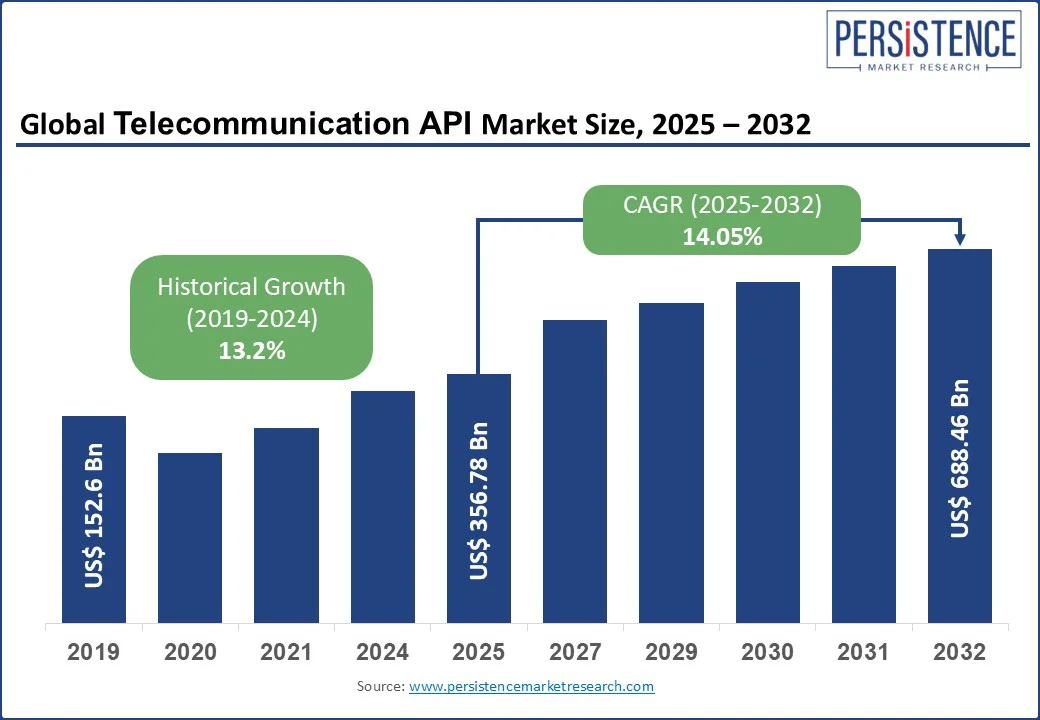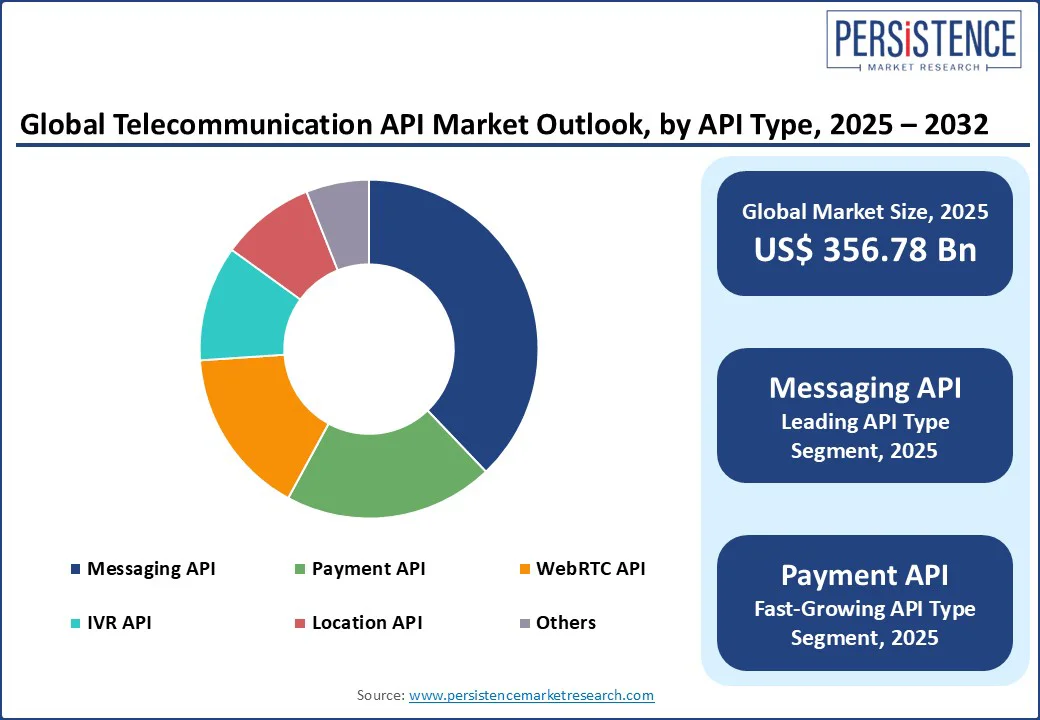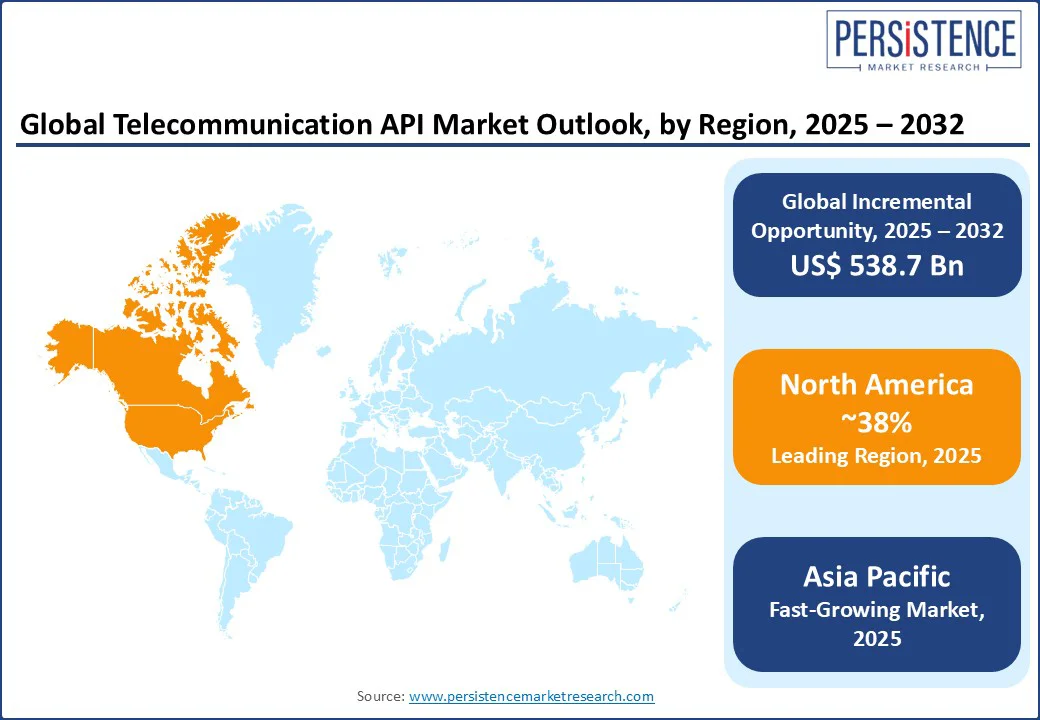ID: PMRREP27739| 203 Pages | 23 Aug 2025 | Format: PDF, Excel, PPT* | IT and Telecommunication

The global telecommunication API market size is expected to be valued at US$356.78 billion in 2025 and reach US$688.46 billion by 2032, growing at a CAGR of 14.05% during the forecast period from 2025 to 2032.
The telecommunication API industry is experiencing significant growth driven by the increasing adoption of 5G networks, the proliferation of IoT devices, and the rising demand for seamless integration of communication services into applications.
Telecommunication APIs, which enable developers to integrate functionalities such as messaging, voice, and location services, are critical for enhancing digital communication and operational efficiency across industries. The surge in mobile app development, cloud-based services, and enterprise demand for real-time communication solutions further fuels market expansion.
Key Industry Highlights:

|
Global Market Attribute |
Key Insights |
|
Telecommunication API Market Size (2025E) |
US$356.78 Bn |
|
Market Value Forecast (2032F) |
US$688.46 Bn |
|
Projected Growth (CAGR 2025 to 2032) |
14.05% |
|
Historical Market Growth (CAGR 2019 to 2024) |
13.2% |
The rapid rollout of 5G networks and the proliferation of IoT devices are primary drivers of the global Telecommunication API market. 5G’s high-speed connectivity, low latency, and massive device support enable advanced use cases such as autonomous vehicles, smart cities, and augmented reality, necessitating APIs for seamless integration.
According to the Ericsson Mobility Report, 5G subscriptions are expected to exceed 5.3 Bn by 2029, driving demand for APIs that expose network capabilities such as quality-on-demand and network slicing. The IoT ecosystem, projected to include 25.2 Bn connections by 2025, relies on APIs for messaging, location, and device management to ensure reliable data exchange.
For instance, Twilio reported a Q1 2025 revenue of US$1.17 Bn, reflecting enterprise demand for API-driven communication solutions. Standardization initiatives such as GSMA Open Gateway, backed by 49 operator groups, simplify developer access to network APIs, as seen in Telefonica’s fintech and streaming integrations. Government support, such as India’s 5G rollout initiatives, and enterprise adoption in sectors such as healthcare and logistics further amplify API demand, ensuring sustained market growth through 2032.
Security vulnerabilities and regulatory complexities pose significant challenges to the Telecommunication API market. The surge in API call volumes in 2024 has exposed platforms to cyberattacks, with incidents such as the TracFone breach resulting in a penalty. Compliance with stringent regulations, such as GDPR in Europe and CCPA in the U.S., complicates API integration, particularly for smaller enterprises.
Legacy OSS/BSS systems, cited by two-thirds of communication service providers as barriers, further delay API monetization due to incompatibility with modern event-based pricing models. These challenges, along with consumer skepticism about data privacy, particularly in regions with low digital literacy, restrict market penetration and slow adoption in certain markets.
The growing emphasis on 5G and edge computing presents significant opportunities for the Telecommunication API market. Edge computing, critical for low-latency applications such as autonomous vehicles and AR/VR, relies on APIs for sub-10 millisecond response times. Ericsson and Intel’s demonstrations of slice selection for enterprise applications highlight a US$300 Bn opportunity by 2025.
Cloud-based API platforms, as seen in AWS’s collaboration with Verizon and Telefonica in 2024, reduce deployment costs, driving scalability. The rise of smart cities and industrial IoT further fuels demand for location and IoT APIs, enabling telecom operators to create new revenue streams through pay-per-use and subscription models, aligning with digital transformation trends.

North America remains the leading region in the Telecommunication API market, accounting for approximately 38% of the global market share in 2025. This dominance is driven by its mature telecom infrastructure, early 5G adoption, and a vibrant developer ecosystem in the U.S. and Canada.
Major players, such as AT&T and Verizon, which leverage APIs for robocall detection and enterprise solutions, are based in the U.S. The region’s cloud-native enterprises and investments in edge computing, such as Microsoft’s US$5 Bn IoT commitment, further drive growth. Regulatory support for open APIs and net neutrality fosters innovation, positioning North America as a hub for API-driven digital transformation.
The Asia Pacific region is the fastest-growing market for Telecommunication APIs, driven by the rapid deployment of 5G, increasing mobile subscribers, and government-led digital initiatives in countries such as China and India. India, with its mobile internet user base growing, is witnessing a significant adoption of APIs for messaging and payment services, supported by initiatives such as the Digital India program.
In 2024, operators such as Bharti Airtel launched GSMA Open Gateway APIs for OTP validation and carrier billing, enhancing digital services. China’s telecom giants, such as China Mobile, drive the growth of IoT and location APIs for smart-city applications. Rising smartphone penetration and fintech-driven messaging surges in countries such as Japan further boost the Telecommunication API market, positioning the Asia Pacific for rapid expansion.
Europe is the second fastest-growing region in the Telecommunication API market, driven by regulatory harmonization, cross-border collaborations, and investments in 5G infrastructure. Germany and France lead due to their strong industrial bases and high demand for M2M and IoT APIs, which aligns with initiatives such as “Industrie 4.0.”
The European Commission’s push for open digital markets encourages the use of standardized APIs, with operators such as Deutsche Telekom launching the MagentaBusiness API platform in 2023. The region’s focus on privacy-centric identity APIs and cloud-based services, coupled with 5G penetration, drives growth. Increasing demand for real-time communication in healthcare and logistics further supports Europe’s robust market expansion.

The global telecommunication API market is highly competitive, with key players dominating through extensive API portfolios and global networks. These companies invest in 5G-driven APIs, cloud platforms, and partnerships with startups to enhance market share. Regional players such as Bharti Airtel focus on localized offerings in the Asia Pacific, while Twilio and Infobip lead in CPaaS solutions, catering to enterprise and developer needs.
The Telecommunication API market is projected to reach US$ 356.78 Bn in 2025.
The surge in 5G adoption, IoT connectivity, and demand for real-time communication solutions are the key market drivers for the Telecommunication API market.
The Telecommunication API market is poised to witness a CAGR of 14.05% from 2025 to 2032.
Monetization of 5G and edge computing APIs is a key market opportunity in the Telecommunication API market.
AT&T, Twilio, Vodafone, Verizon, Huawei, Ericsson, Telefonica, Infobip, Bharti Airtel, and Deutsche Telekom are key market players.
|
Report Attribute |
Details |
|
Historical Data/Actuals |
2019 - 2024 |
|
Forecast Period |
2025 - 2032 |
|
Market Analysis Units |
Value: US$ Bn/Mn, Volume: As Applicable |
|
Geographical Coverage |
|
|
Segmental Coverage |
|
|
Competitive Analysis |
|
|
Report Highlights |
|
|
Customization and Pricing |
Available upon request |
By API Type
By Deployment Type
By End-use
By Region
Delivery Timelines
For more information on this report and its delivery timelines please get in touch with our sales team.
About Author